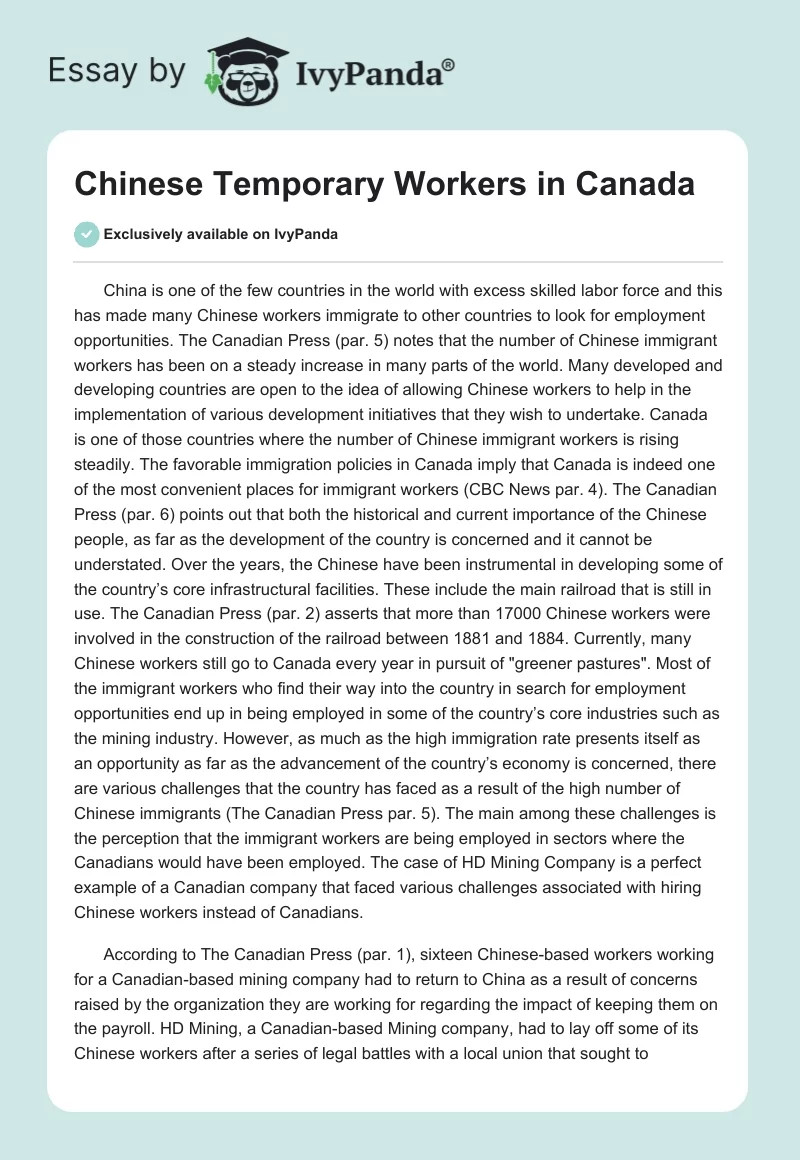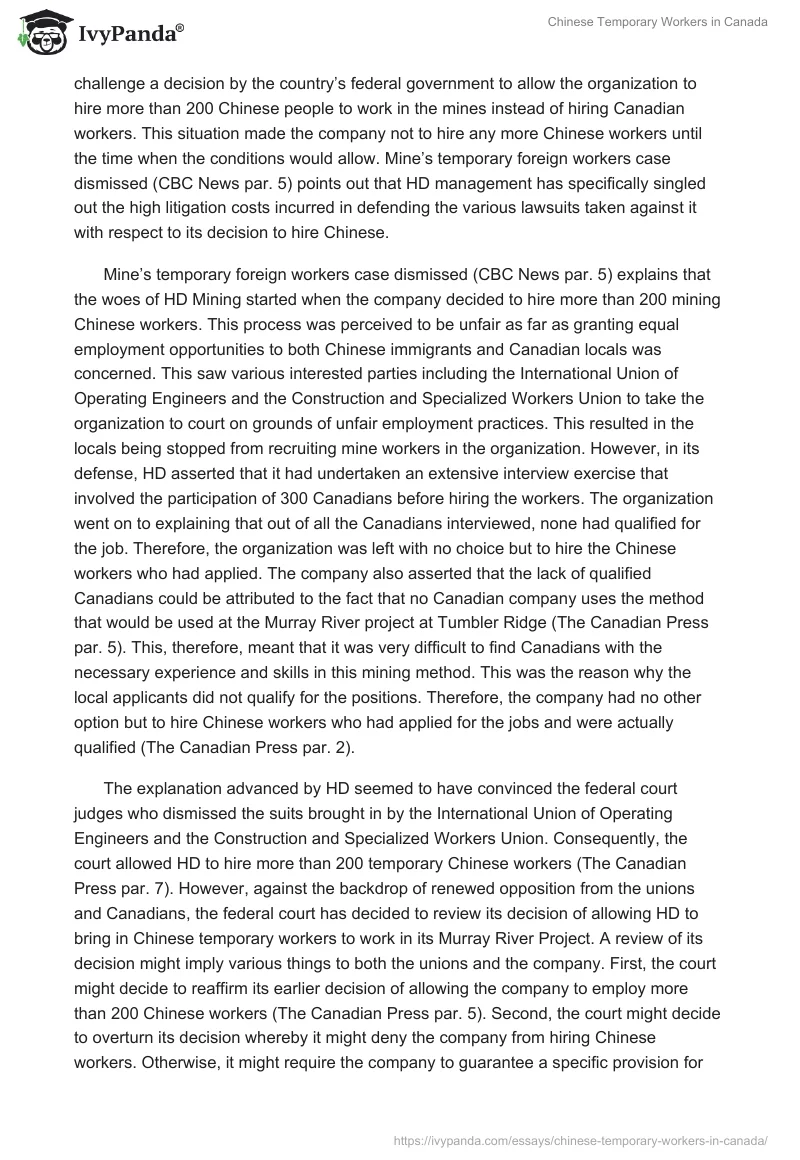China is one of the few countries in the world with excess skilled labor force and this has made many Chinese workers immigrate to other countries to look for employment opportunities. The Canadian Press (par. 5) notes that the number of Chinese immigrant workers has been on a steady increase in many parts of the world. Many developed and developing countries are open to the idea of allowing Chinese workers to help in the implementation of various development initiatives that they wish to undertake. Canada is one of those countries where the number of Chinese immigrant workers is rising steadily. The favorable immigration policies in Canada imply that Canada is indeed one of the most convenient places for immigrant workers (CBC News par. 4). The Canadian Press (par. 6) points out that both the historical and current importance of the Chinese people, as far as the development of the country is concerned and it cannot be understated. Over the years, the Chinese have been instrumental in developing some of the country’s core infrastructural facilities. These include the main railroad that is still in use. The Canadian Press (par. 2) asserts that more than 17000 Chinese workers were involved in the construction of the railroad between 1881 and 1884. Currently, many Chinese workers still go to Canada every year in pursuit of “greener pastures”. Most of the immigrant workers who find their way into the country in search for employment opportunities end up in being employed in some of the country’s core industries such as the mining industry. However, as much as the high immigration rate presents itself as an opportunity as far as the advancement of the country’s economy is concerned, there are various challenges that the country has faced as a result of the high number of Chinese immigrants (The Canadian Press par. 5). The main among these challenges is the perception that the immigrant workers are being employed in sectors where the Canadians would have been employed. The case of HD Mining Company is a perfect example of a Canadian company that faced various challenges associated with hiring Chinese workers instead of Canadians.
According to The Canadian Press (par. 1), sixteen Chinese-based workers working for a Canadian-based mining company had to return to China as a result of concerns raised by the organization they are working for regarding the impact of keeping them on the payroll. HD Mining, a Canadian-based Mining company, had to lay off some of its Chinese workers after a series of legal battles with a local union that sought to challenge a decision by the country’s federal government to allow the organization to hire more than 200 Chinese people to work in the mines instead of hiring Canadian workers. This situation made the company not to hire any more Chinese workers until the time when the conditions would allow. Mine’s temporary foreign workers case dismissed (CBC News par. 5) points out that HD management has specifically singled out the high litigation costs incurred in defending the various lawsuits taken against it with respect to its decision to hire Chinese.
Mine’s temporary foreign workers case dismissed (CBC News par. 5) explains that the woes of HD Mining started when the company decided to hire more than 200 mining Chinese workers. This process was perceived to be unfair as far as granting equal employment opportunities to both Chinese immigrants and Canadian locals was concerned. This saw various interested parties including the International Union of Operating Engineers and the Construction and Specialized Workers Union to take the organization to court on grounds of unfair employment practices. This resulted in the locals being stopped from recruiting mine workers in the organization. However, in its defense, HD asserted that it had undertaken an extensive interview exercise that involved the participation of 300 Canadians before hiring the workers. The organization went on to explaining that out of all the Canadians interviewed, none had qualified for the job. Therefore, the organization was left with no choice but to hire the Chinese workers who had applied. The company also asserted that the lack of qualified Canadians could be attributed to the fact that no Canadian company uses the method that would be used at the Murray River project at Tumbler Ridge (The Canadian Press par. 5). This, therefore, meant that it was very difficult to find Canadians with the necessary experience and skills in this mining method. This was the reason why the local applicants did not qualify for the positions. Therefore, the company had no other option but to hire Chinese workers who had applied for the jobs and were actually qualified (The Canadian Press par. 2).
The explanation advanced by HD seemed to have convinced the federal court judges who dismissed the suits brought in by the International Union of Operating Engineers and the Construction and Specialized Workers Union. Consequently, the court allowed HD to hire more than 200 temporary Chinese workers (The Canadian Press par. 7). However, against the backdrop of renewed opposition from the unions and Canadians, the federal court has decided to review its decision of allowing HD to bring in Chinese temporary workers to work in its Murray River Project. A review of its decision might imply various things to both the unions and the company. First, the court might decide to reaffirm its earlier decision of allowing the company to employ more than 200 Chinese workers (The Canadian Press par. 5). Second, the court might decide to overturn its decision whereby it might deny the company from hiring Chinese workers. Otherwise, it might require the company to guarantee a specific provision for local workers whereby, approximately twenty percent of the workforce must comprise of people from the local population (CBC News par. 2).
All in all, there are several questions that come up from the HD’s international case regarding the issues facing the country with respect to Chinese temporary workers. First and foremost, to what extent should locally-based companies go in order to ensure that the local population is sufficiently integrated into their workforce? The case presented by HD reveals that the organization actually undertook an interview process that saw the Chinese, other immigrant applicants, and local applicants granted an equal chance of applying for the job and being hired by the company. Unfortunately, none of the 300 Canadian applicants who applied for these positions qualified for employment. Despite this fact, the company was castigated by local unions for unfair employment practices whereby it ended up hiring only Chinese nationals to work on its proposed project. It was unfair to castigate HD Mining for unfair employment practices whereas it had ensured that it accorded equal opportunities to all the applicants irrespective of their nationality. In addition to that, it is important to consider the aspirations of the company in regard to its goals and objectives and the extent to which the company will be able to realize these objectives by employing Canadians only. This should be compared to the benefits of a balanced workforce. In order to realize its operational objectives and consequently enhance the performance of the company, HD Mining wanted to use a new mining technique that was unique in the country. No other company had ever previously used this technique in Canada. This situation meant that it would have been very difficult to find people from the local population who were well versed with this technique. This was one of the key requirements that were being considered in the interviews (CBC News par. 5). On the other hand, considering that the proposed mining technology was already in existence in China, it was easier to find Chinese people who were well versed with the proposed technology. This was the main reason why the company had to hire a Chinese-based workforce predominantly. Finally, Mine’s temporary foreign workers case dismissed (CBC News par. 4) points out that most Canadians shun away from technical and manual jobs and this is what the mining jobs actually entail. Therefore, only a few Canadians applied for these jobs and perhaps, the situation would have been a little bit different had more Canadians applied for the positions.
From the foregoing discussion, countries should be extremely keen when employing people from other nationalities. Workers’ unions are mainly concerned about the employment rights of the citizens in a country. If the employment rights of the locals are violated, the workers’ unions try to ensure that the citizens are accorded their rights.
Works Cited
CBC News. “Mine’s temporary foreign workers case dismissed: HD Mining International calls ruling ‘a complete vindication.”CBC News. n. p.
The Canadian Press. “HD Mining Sends Chinese Workers Home.” Huffpost British Columbia. n.p., 2013. Web.


